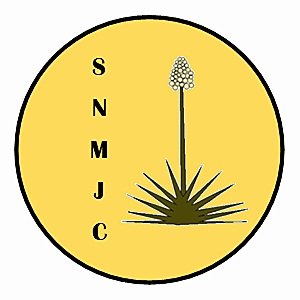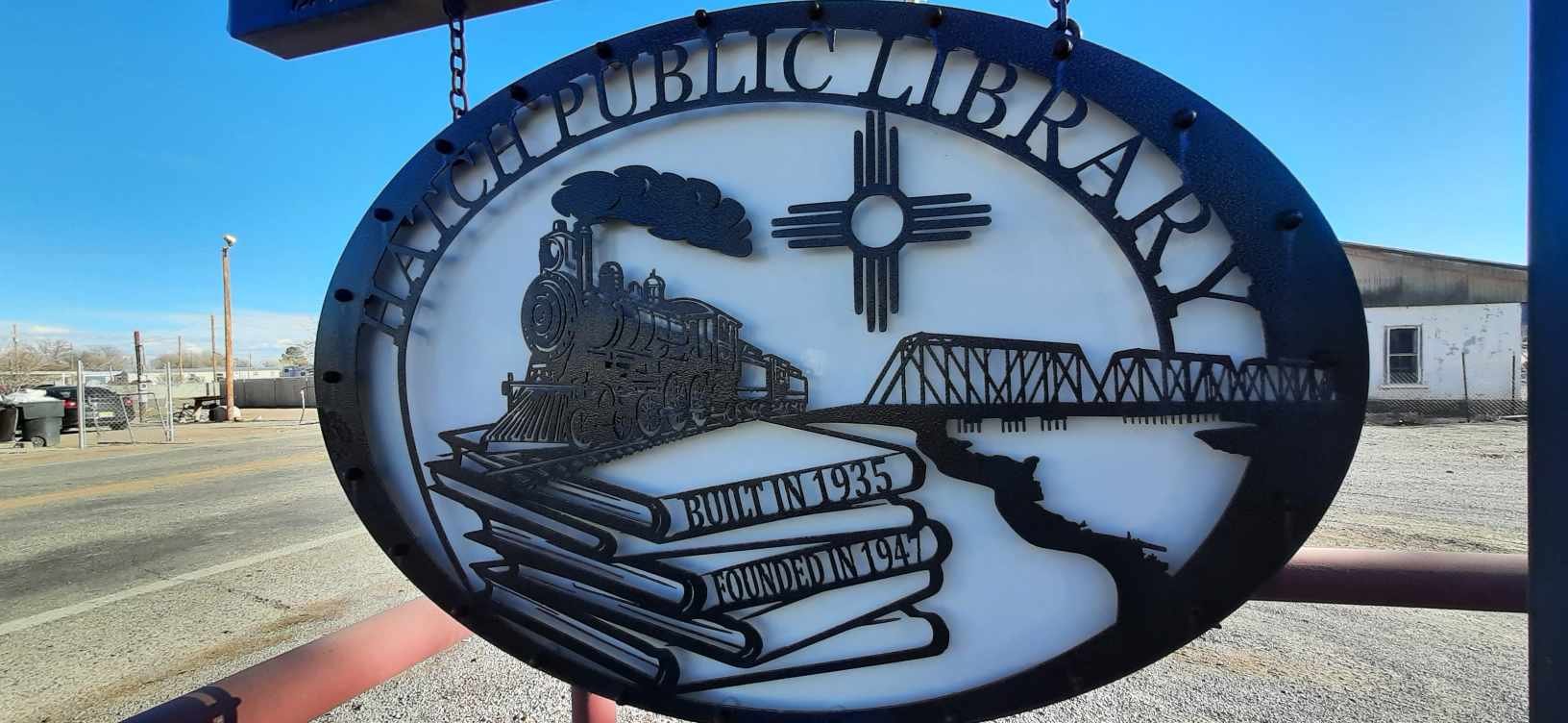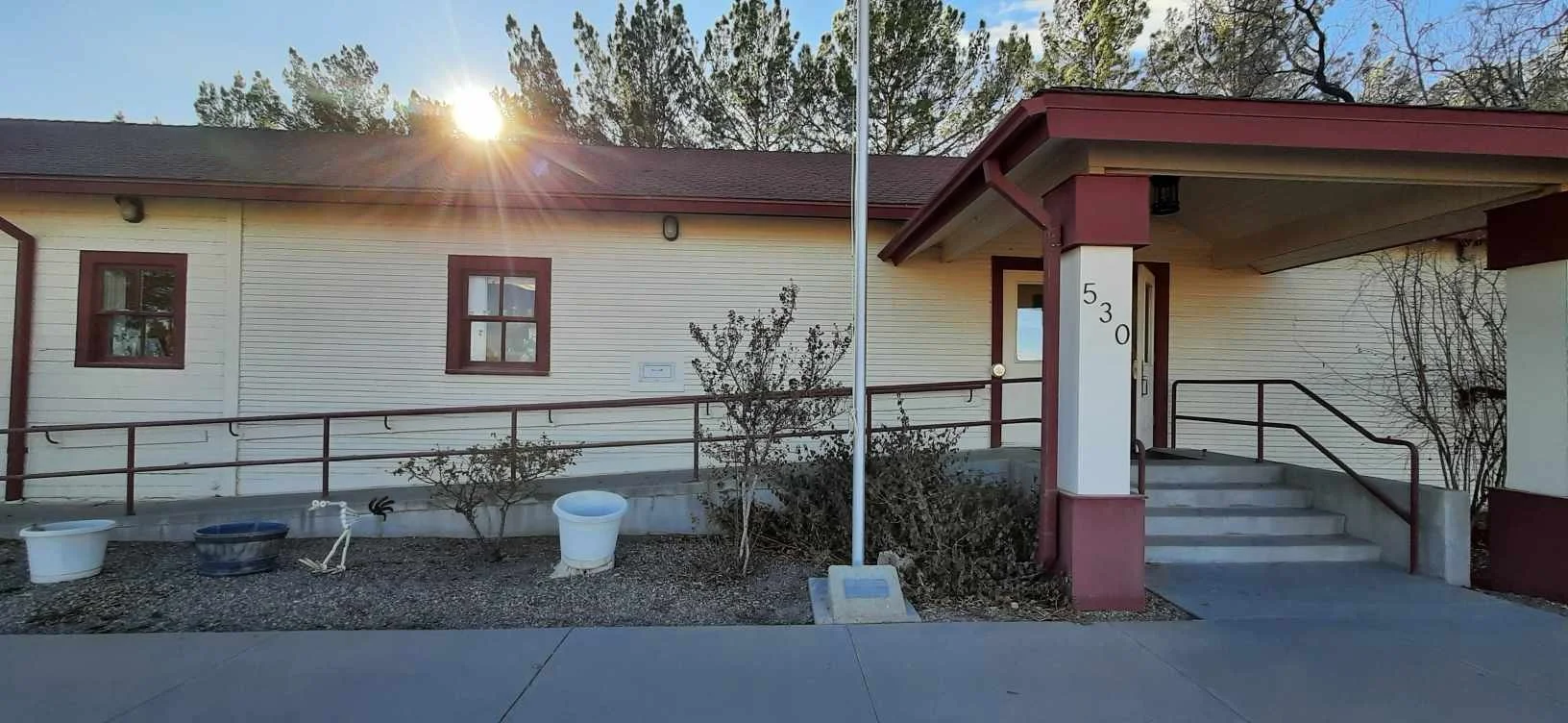Hatch, N.M. library among 55 to benefit from state endowment
The Hatch Public Library, 530 E. Hall St., is among 55 libraries statewide that will receive funding from a young endowment. Lawmakers are considering fully funding the measure in the legislative session now underway in Santa Fe. (Photo by: Diana Alba Soular/ SNMJC)
From historic train depot, rural residents connect to Wi-Fi, translation help and more
HATCH – A white building with dark brown trim and a U.S. flag out front stands on the outskirts of this roughly 1,500-person agricultural community. To passersby on N.M. Hwy. 185, an artistic sign depicts a locomotive charging full speed ahead across a stack of books.
At a glance, the image showcases both the Hatch Public Library’s mission and history. The building is a former train depot – or, at least part of it.
“In 1987, they cut it in half and moved it to its current location,” said Hatch Public Library Director Lisa Neal.
Inside, the library curates a cozy feel, in addition to an inventory of 22,000 books, magazines and other materials. On a recent day, two people sit on a couch toward one end of a large room, one reading and another listening to a headset. To the left of the main door are a service counter and office space where Neal and a work-study assistant are stationed. A row of computers sits against one wall; one patron is browsing the web. Relics of the old train depot – like a set of scales and original signage – dot the room.
A walk down a short hallway leads to a sizable children’s library and reading room. The library hosts children’s programs featuring science, technology, engineering and math, as well as summer reading. Families can check out themed kits with books, puzzles and toys.
The library also features free Wi-Fi – a true resource in a rural community that’s roughly a 45-minute drive from the much larger city of Las Cruces.
“Being that we are from Hatch, there's not a Kinko's around the corner,” Neal said. “We provide a lot of the printing necessities the community needs. A lot of people don't have a computer or internet or Wi-Fi, so we'll have a lot of patrons outside utilizing our Wi-Fi.”
Magdalena Hinckley, a Utah resident spending the winter in Southern New Mexico, visits the Hatch Public Library on Thursday, Jan. 25, 2024 to review yearbooks from the late 1960s. She attended Hatch schools through the seventh grade and says she’s glad the library had the books on hand. (Photo by: Diana Alba Soular/ SNMJC)
Some library visitors get help with basic tech support. They might have a computer but not know how to use it. Or, maybe they don’t own a computer or device at all. Sometimes elderly residents need help taking a picture with their cell phone or sending a text message.
Neal’s bilingual assistant, Alice Soto, helps Spanish-speaking residents translate important documents, such as work permits, citizenship applications and unemployment from English. Library card holders can access a free language learning tutorial called Mango. These services are especially important because many migrant farmworkers live and work in the area.
“We became that place where people know to go,” Neal said. “And, if we can help, we refer them to where they actually need to go.”
The village of Hatch allocates about $100,000 each year towards library operations, most of which goes towards salaries and purchasing some materials. The library gets another $7,000 from a state library system grant.
The Hatch Public Library is one of 55 that benefit from a rural libraries endowment that’s roughly half-way funded. Supporters of the initiative are seeking another $27 million in the legislative session that ends Feb. 15. The proposed funding seems in limbo at the moment, but, if successful, rural libraries statewide each could receive about $45,000 per year from the endowment, support that would last indefinitely.
“I hope that the money increases because small libraries like ours and others around New Mexico – when you're in a rural area, you don't have that huge tax base like Las Cruces and other cities have,” she said. “So, we do struggle.”
The Hatch Public Library is housed in a former train depot that was moved to its location off N.M. Hwy. 185 in the late 1980s. (Photo by: Diana Alba Soular/ SNMJC)
Among the handful of library visitors on a recent afternoon was Magdalena Hinckley. As a child, she lived in Hatch, but moved away when she was 14. She said she’s always loved the community and was “shattered” when her parents uprooted the family. To reconnect with her past, Hinckley sat with a pile of yearbooks from the late 1960s, excitedly flipping through them to see how her friends and classmates had fared in school after she left. To be able to access a repository that included the yearbooks was “amazing,” she said.
“This is so cool they have these,” she said. “I’m just happy they have them. There’s always a way to come back.”
The library attracts visitors from communities around Hatch and even some from Las Cruces.
Neal said if the endowment is fully funded, there’s lots of potential for how she could increase library services, like hosting more speakers, entertainers and children’s programs or buying Wi-Fi hot spots and tablets for residents to check out.
The village also has plans to expand the library, but at a new location. The building would be part library, part visitor center and part museum. It has secured funding for land and the design, but is also seeking additional money.
Asked if she planned to drive more than three-and-a-half hours to Santa Fe to speak on behalf of a funded state library endowment, Neal didn’t hesitate: “I don't have the time. I’m on a shoestring budget.”
Relics of the former train depot that now is home to the Hatch Public Library can be seen inside the building, 530 E. Hall St., Hatch, New Mexico. (Photo by: Diana Alba Soular/ SNMJC)
At a Glance
What: Hatch Public Library
When: 10 a.m. to 6 p.m. Monday to Friday; 10 a.m. to 2 p.m. Saturday
Where: 530 E. Hall St., Hatch, N.M.
Info: https://www.g3online.com/hatch_pl/




